Strategic Direction, Leadership, and Analysis for Sainsbury's (HRM706)
VerifiedAdded on 2022/12/28
|13
|4229
|2
Report
AI Summary
This report provides a comprehensive analysis of Sainsbury's strategic direction, aligning with the QUALIFI Level 7 Diploma in Strategic Management and Leadership unit HRM706. The report critically examines Sainsbury's strategic aims and objectives, evaluating their effectiveness and alignment with the company's mission and vision. It delves into the components of Sainsbury's current organizational strategy, assessing its strengths, weaknesses, opportunities, and threats. The analysis extends to the factors influencing strategic aims in the short and medium term, including environmental considerations, corporate culture, and stakeholder pressures. The report employs analytical tools like Porter's value chain to audit and assess progress toward existing strategic aims. It critically assesses stakeholder expectations and their influence on future strategy, considering their power and interests. Furthermore, the report evaluates Sainsbury's existing strategic position and progress, developing and justifying alternative strategic options to meet organizational goals, direction, and objectives in the short and medium term. This report provides a thorough understanding of Sainsbury's strategic landscape, offering valuable insights into its management and leadership approaches.
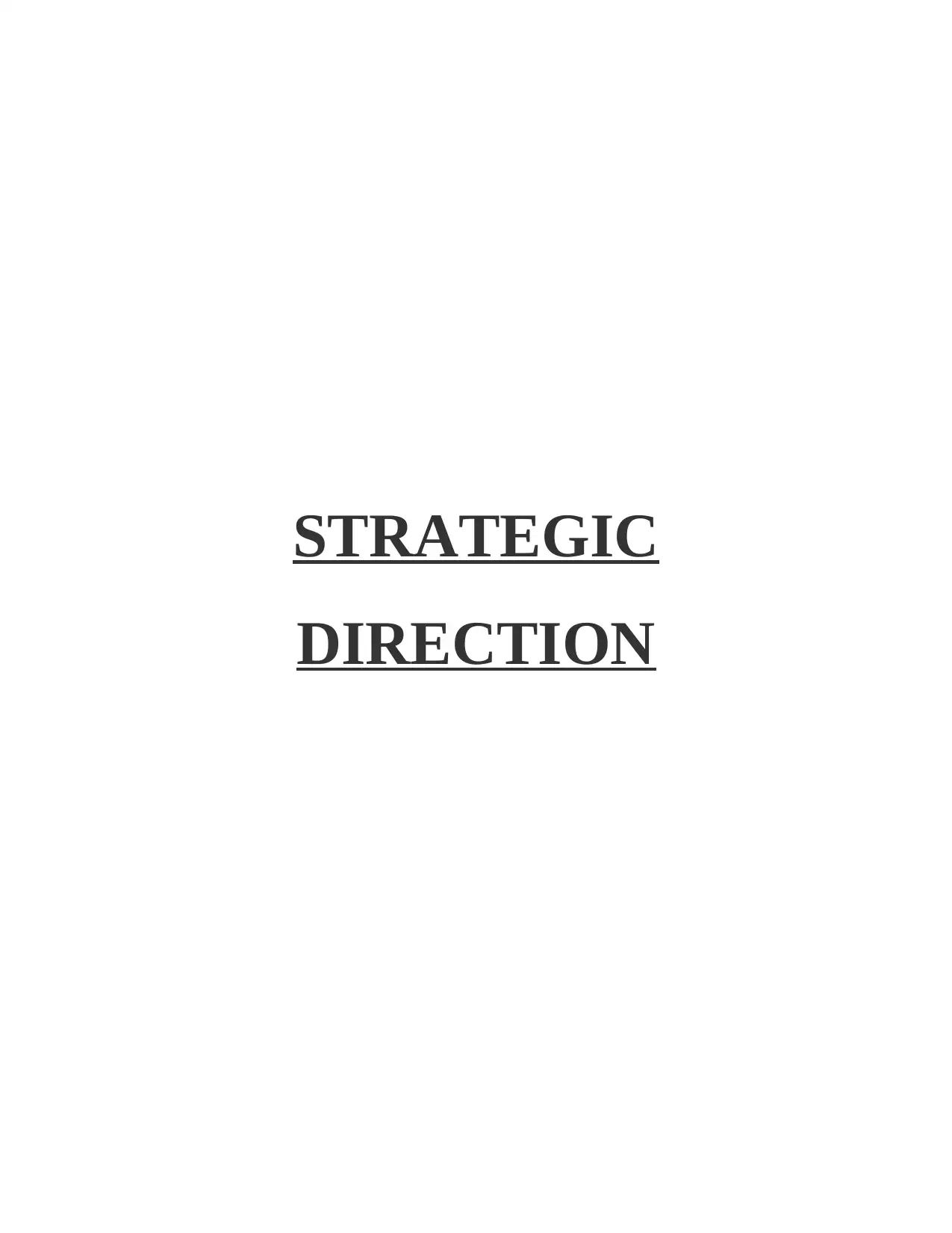
STRATEGIC
DIRECTION
DIRECTION
Paraphrase This Document
Need a fresh take? Get an instant paraphrase of this document with our AI Paraphraser
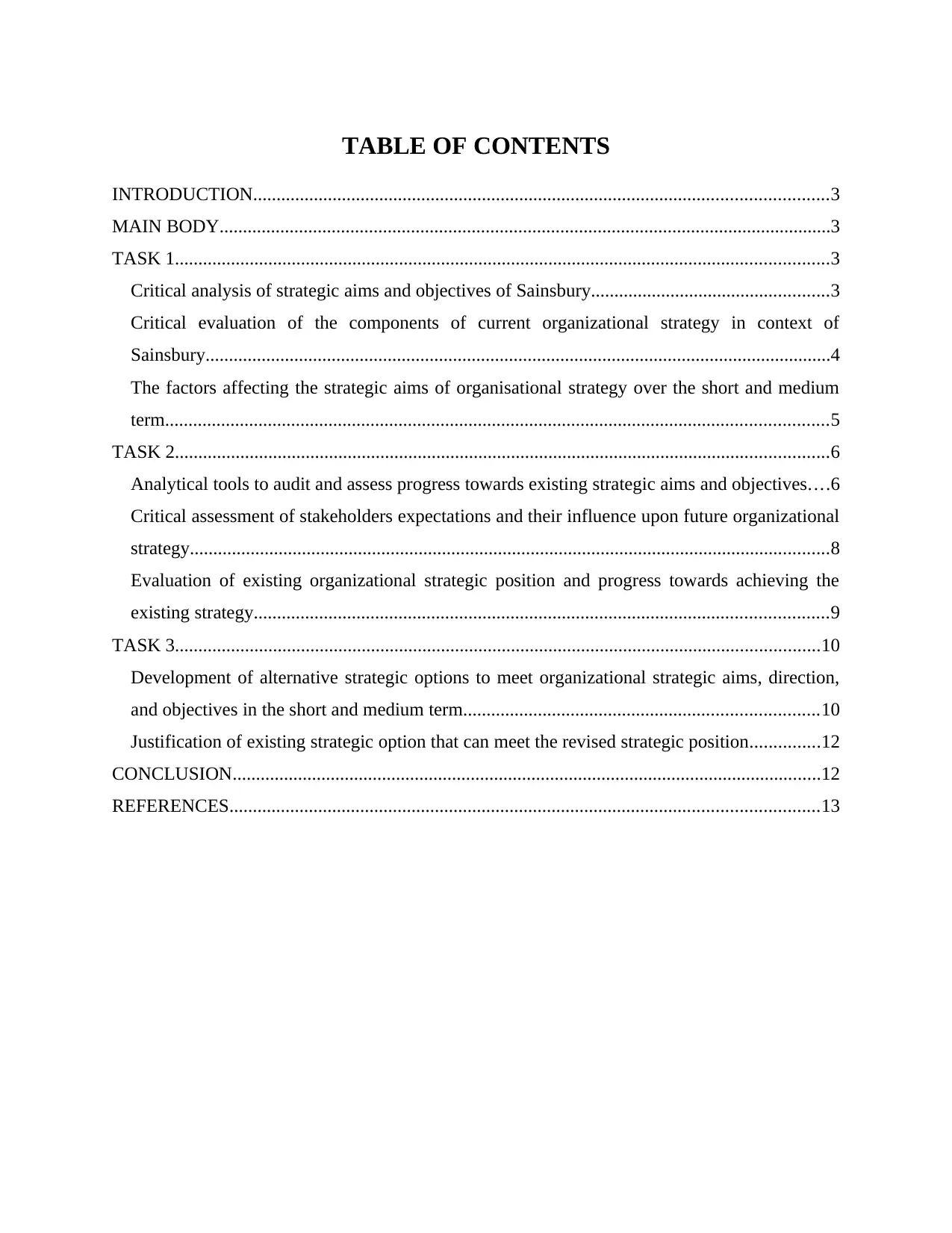
TABLE OF CONTENTS
INTRODUCTION...........................................................................................................................3
MAIN BODY...................................................................................................................................3
TASK 1............................................................................................................................................3
Critical analysis of strategic aims and objectives of Sainsbury...................................................3
Critical evaluation of the components of current organizational strategy in context of
Sainsbury......................................................................................................................................4
The factors affecting the strategic aims of organisational strategy over the short and medium
term..............................................................................................................................................5
TASK 2............................................................................................................................................6
Analytical tools to audit and assess progress towards existing strategic aims and objectives....6
Critical assessment of stakeholders expectations and their influence upon future organizational
strategy.........................................................................................................................................8
Evaluation of existing organizational strategic position and progress towards achieving the
existing strategy...........................................................................................................................9
TASK 3..........................................................................................................................................10
Development of alternative strategic options to meet organizational strategic aims, direction,
and objectives in the short and medium term............................................................................10
Justification of existing strategic option that can meet the revised strategic position...............12
CONCLUSION..............................................................................................................................12
REFERENCES..............................................................................................................................13
INTRODUCTION...........................................................................................................................3
MAIN BODY...................................................................................................................................3
TASK 1............................................................................................................................................3
Critical analysis of strategic aims and objectives of Sainsbury...................................................3
Critical evaluation of the components of current organizational strategy in context of
Sainsbury......................................................................................................................................4
The factors affecting the strategic aims of organisational strategy over the short and medium
term..............................................................................................................................................5
TASK 2............................................................................................................................................6
Analytical tools to audit and assess progress towards existing strategic aims and objectives....6
Critical assessment of stakeholders expectations and their influence upon future organizational
strategy.........................................................................................................................................8
Evaluation of existing organizational strategic position and progress towards achieving the
existing strategy...........................................................................................................................9
TASK 3..........................................................................................................................................10
Development of alternative strategic options to meet organizational strategic aims, direction,
and objectives in the short and medium term............................................................................10
Justification of existing strategic option that can meet the revised strategic position...............12
CONCLUSION..............................................................................................................................12
REFERENCES..............................................................................................................................13
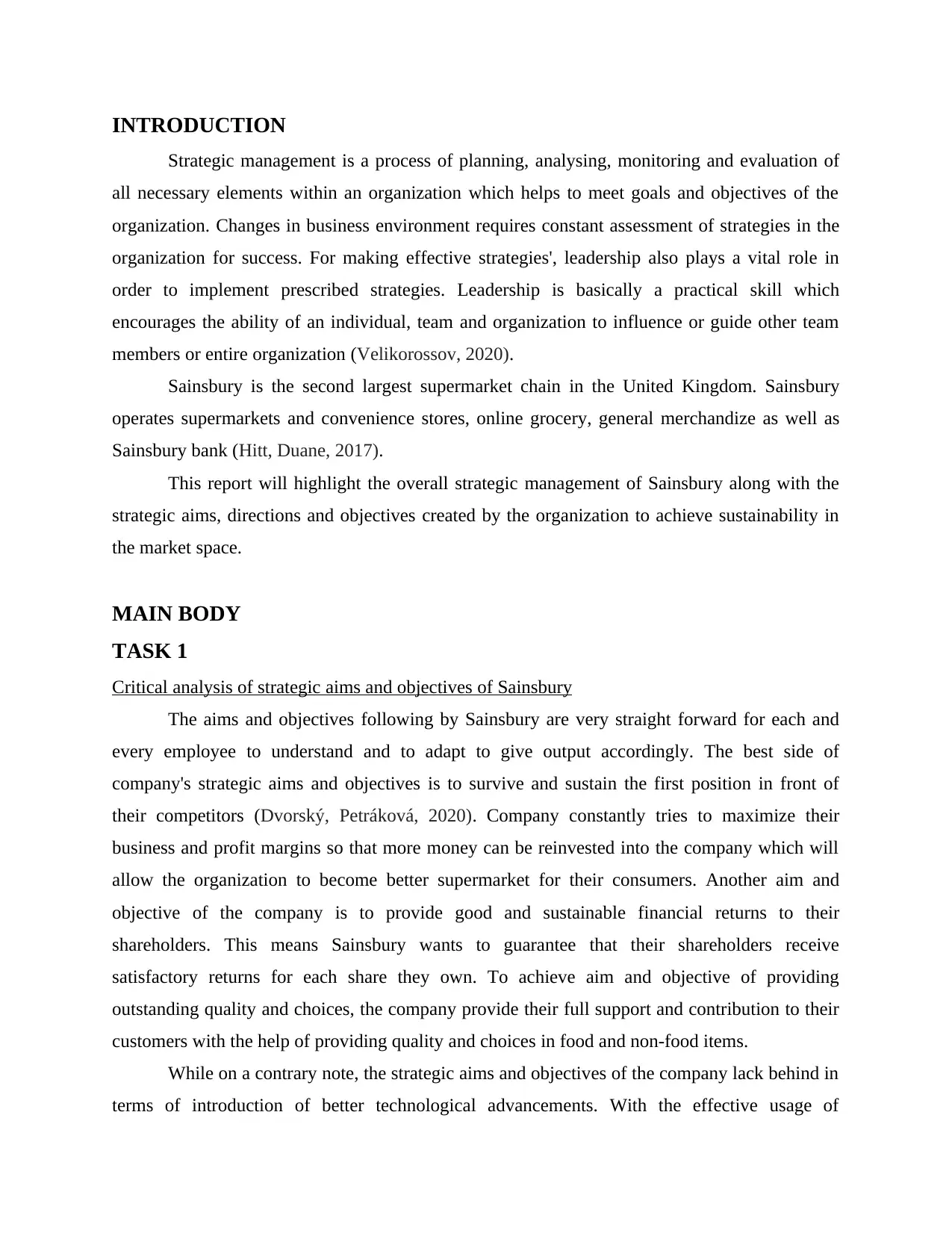
INTRODUCTION
Strategic management is a process of planning, analysing, monitoring and evaluation of
all necessary elements within an organization which helps to meet goals and objectives of the
organization. Changes in business environment requires constant assessment of strategies in the
organization for success. For making effective strategies', leadership also plays a vital role in
order to implement prescribed strategies. Leadership is basically a practical skill which
encourages the ability of an individual, team and organization to influence or guide other team
members or entire organization (Velikorossov, 2020).
Sainsbury is the second largest supermarket chain in the United Kingdom. Sainsbury
operates supermarkets and convenience stores, online grocery, general merchandize as well as
Sainsbury bank (Hitt, Duane, 2017).
This report will highlight the overall strategic management of Sainsbury along with the
strategic aims, directions and objectives created by the organization to achieve sustainability in
the market space.
MAIN BODY
TASK 1
Critical analysis of strategic aims and objectives of Sainsbury
The aims and objectives following by Sainsbury are very straight forward for each and
every employee to understand and to adapt to give output accordingly. The best side of
company's strategic aims and objectives is to survive and sustain the first position in front of
their competitors (Dvorský, Petráková, 2020). Company constantly tries to maximize their
business and profit margins so that more money can be reinvested into the company which will
allow the organization to become better supermarket for their consumers. Another aim and
objective of the company is to provide good and sustainable financial returns to their
shareholders. This means Sainsbury wants to guarantee that their shareholders receive
satisfactory returns for each share they own. To achieve aim and objective of providing
outstanding quality and choices, the company provide their full support and contribution to their
customers with the help of providing quality and choices in food and non-food items.
While on a contrary note, the strategic aims and objectives of the company lack behind in
terms of introduction of better technological advancements. With the effective usage of
Strategic management is a process of planning, analysing, monitoring and evaluation of
all necessary elements within an organization which helps to meet goals and objectives of the
organization. Changes in business environment requires constant assessment of strategies in the
organization for success. For making effective strategies', leadership also plays a vital role in
order to implement prescribed strategies. Leadership is basically a practical skill which
encourages the ability of an individual, team and organization to influence or guide other team
members or entire organization (Velikorossov, 2020).
Sainsbury is the second largest supermarket chain in the United Kingdom. Sainsbury
operates supermarkets and convenience stores, online grocery, general merchandize as well as
Sainsbury bank (Hitt, Duane, 2017).
This report will highlight the overall strategic management of Sainsbury along with the
strategic aims, directions and objectives created by the organization to achieve sustainability in
the market space.
MAIN BODY
TASK 1
Critical analysis of strategic aims and objectives of Sainsbury
The aims and objectives following by Sainsbury are very straight forward for each and
every employee to understand and to adapt to give output accordingly. The best side of
company's strategic aims and objectives is to survive and sustain the first position in front of
their competitors (Dvorský, Petráková, 2020). Company constantly tries to maximize their
business and profit margins so that more money can be reinvested into the company which will
allow the organization to become better supermarket for their consumers. Another aim and
objective of the company is to provide good and sustainable financial returns to their
shareholders. This means Sainsbury wants to guarantee that their shareholders receive
satisfactory returns for each share they own. To achieve aim and objective of providing
outstanding quality and choices, the company provide their full support and contribution to their
customers with the help of providing quality and choices in food and non-food items.
While on a contrary note, the strategic aims and objectives of the company lack behind in
terms of introduction of better technological advancements. With the effective usage of
⊘ This is a preview!⊘
Do you want full access?
Subscribe today to unlock all pages.

Trusted by 1+ million students worldwide
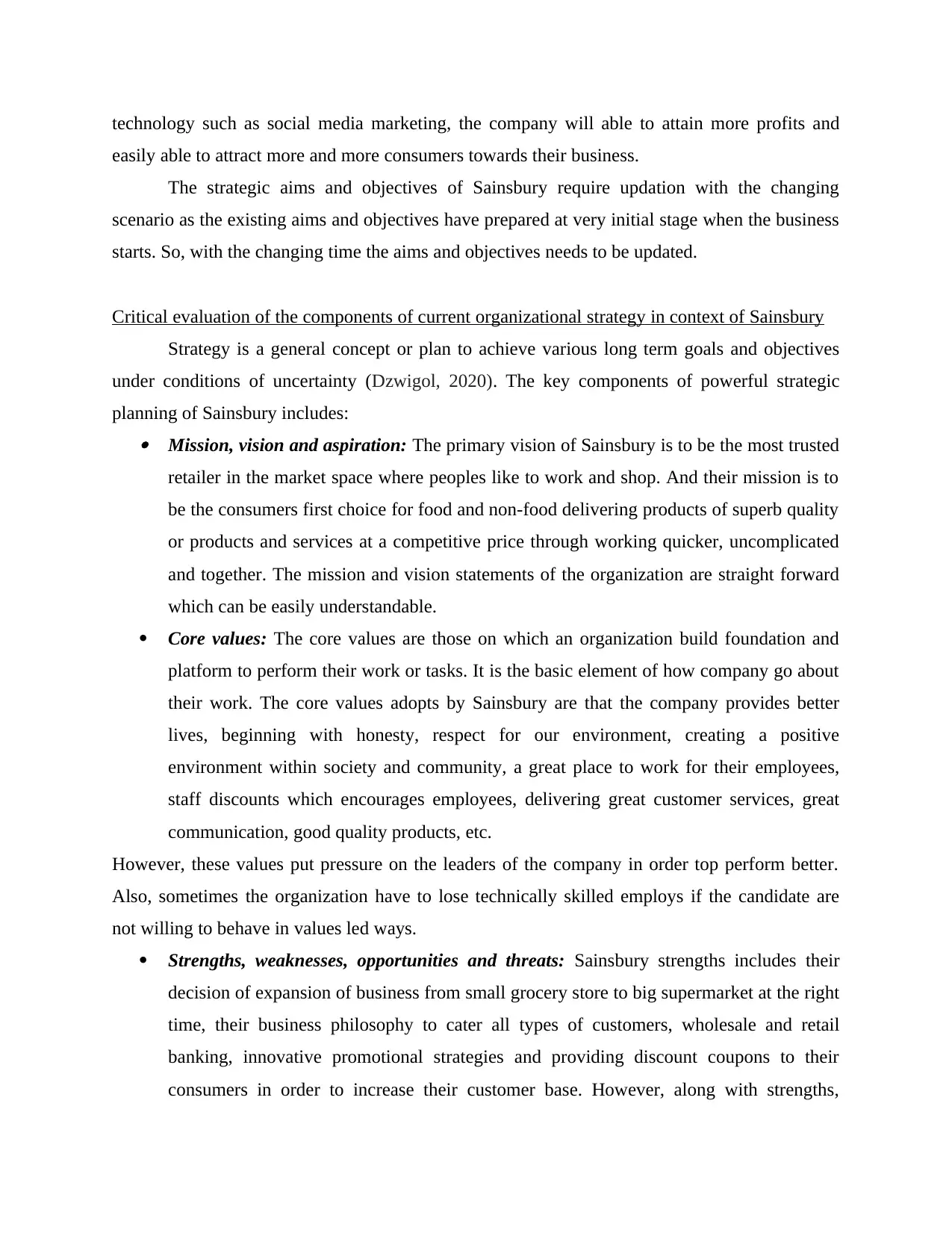
technology such as social media marketing, the company will able to attain more profits and
easily able to attract more and more consumers towards their business.
The strategic aims and objectives of Sainsbury require updation with the changing
scenario as the existing aims and objectives have prepared at very initial stage when the business
starts. So, with the changing time the aims and objectives needs to be updated.
Critical evaluation of the components of current organizational strategy in context of Sainsbury
Strategy is a general concept or plan to achieve various long term goals and objectives
under conditions of uncertainty (Dzwigol, 2020). The key components of powerful strategic
planning of Sainsbury includes: Mission, vision and aspiration: The primary vision of Sainsbury is to be the most trusted
retailer in the market space where peoples like to work and shop. And their mission is to
be the consumers first choice for food and non-food delivering products of superb quality
or products and services at a competitive price through working quicker, uncomplicated
and together. The mission and vision statements of the organization are straight forward
which can be easily understandable.
Core values: The core values are those on which an organization build foundation and
platform to perform their work or tasks. It is the basic element of how company go about
their work. The core values adopts by Sainsbury are that the company provides better
lives, beginning with honesty, respect for our environment, creating a positive
environment within society and community, a great place to work for their employees,
staff discounts which encourages employees, delivering great customer services, great
communication, good quality products, etc.
However, these values put pressure on the leaders of the company in order top perform better.
Also, sometimes the organization have to lose technically skilled employs if the candidate are
not willing to behave in values led ways.
Strengths, weaknesses, opportunities and threats: Sainsbury strengths includes their
decision of expansion of business from small grocery store to big supermarket at the right
time, their business philosophy to cater all types of customers, wholesale and retail
banking, innovative promotional strategies and providing discount coupons to their
consumers in order to increase their customer base. However, along with strengths,
easily able to attract more and more consumers towards their business.
The strategic aims and objectives of Sainsbury require updation with the changing
scenario as the existing aims and objectives have prepared at very initial stage when the business
starts. So, with the changing time the aims and objectives needs to be updated.
Critical evaluation of the components of current organizational strategy in context of Sainsbury
Strategy is a general concept or plan to achieve various long term goals and objectives
under conditions of uncertainty (Dzwigol, 2020). The key components of powerful strategic
planning of Sainsbury includes: Mission, vision and aspiration: The primary vision of Sainsbury is to be the most trusted
retailer in the market space where peoples like to work and shop. And their mission is to
be the consumers first choice for food and non-food delivering products of superb quality
or products and services at a competitive price through working quicker, uncomplicated
and together. The mission and vision statements of the organization are straight forward
which can be easily understandable.
Core values: The core values are those on which an organization build foundation and
platform to perform their work or tasks. It is the basic element of how company go about
their work. The core values adopts by Sainsbury are that the company provides better
lives, beginning with honesty, respect for our environment, creating a positive
environment within society and community, a great place to work for their employees,
staff discounts which encourages employees, delivering great customer services, great
communication, good quality products, etc.
However, these values put pressure on the leaders of the company in order top perform better.
Also, sometimes the organization have to lose technically skilled employs if the candidate are
not willing to behave in values led ways.
Strengths, weaknesses, opportunities and threats: Sainsbury strengths includes their
decision of expansion of business from small grocery store to big supermarket at the right
time, their business philosophy to cater all types of customers, wholesale and retail
banking, innovative promotional strategies and providing discount coupons to their
consumers in order to increase their customer base. However, along with strengths,
Paraphrase This Document
Need a fresh take? Get an instant paraphrase of this document with our AI Paraphraser
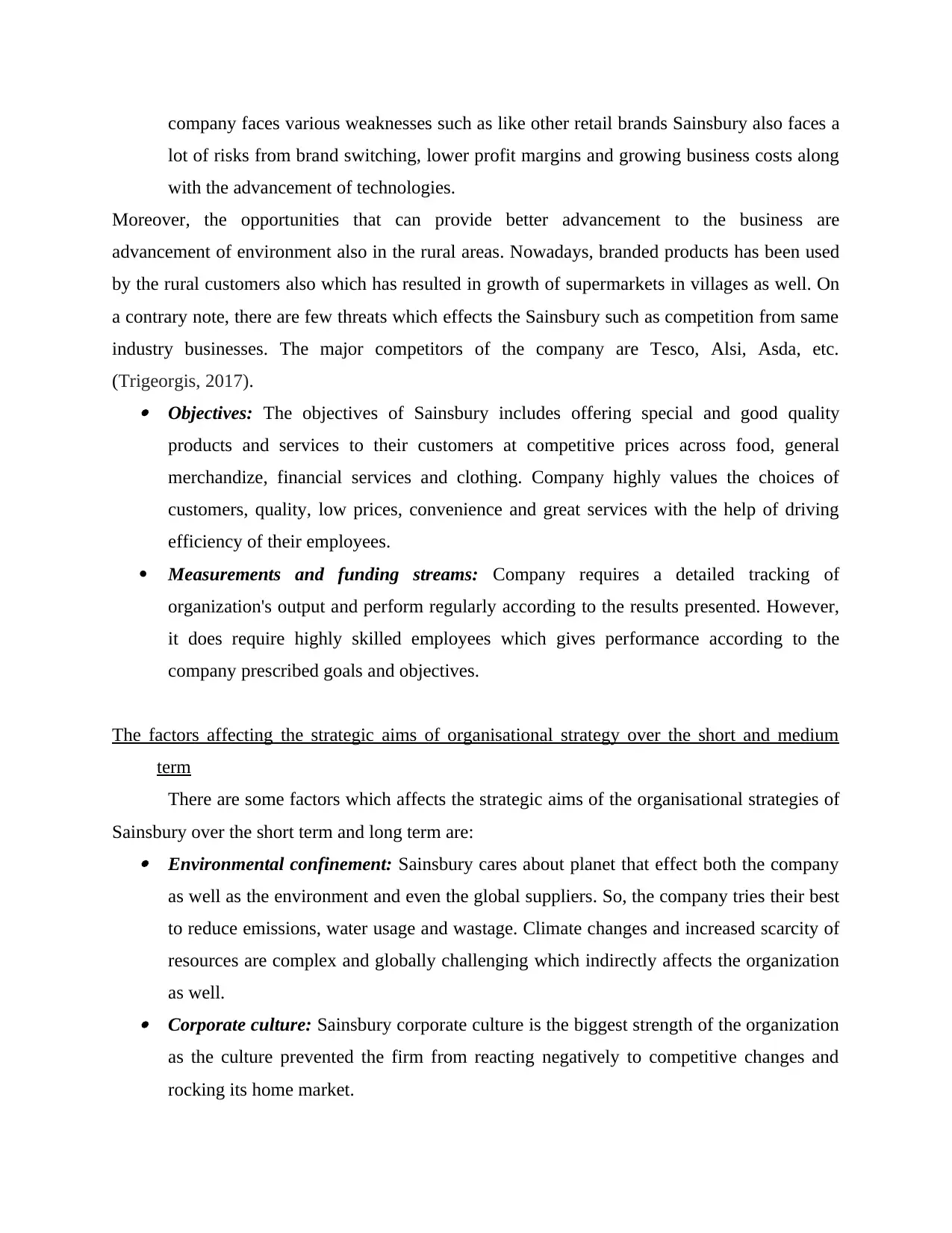
company faces various weaknesses such as like other retail brands Sainsbury also faces a
lot of risks from brand switching, lower profit margins and growing business costs along
with the advancement of technologies.
Moreover, the opportunities that can provide better advancement to the business are
advancement of environment also in the rural areas. Nowadays, branded products has been used
by the rural customers also which has resulted in growth of supermarkets in villages as well. On
a contrary note, there are few threats which effects the Sainsbury such as competition from same
industry businesses. The major competitors of the company are Tesco, Alsi, Asda, etc.
(Trigeorgis, 2017). Objectives: The objectives of Sainsbury includes offering special and good quality
products and services to their customers at competitive prices across food, general
merchandize, financial services and clothing. Company highly values the choices of
customers, quality, low prices, convenience and great services with the help of driving
efficiency of their employees.
Measurements and funding streams: Company requires a detailed tracking of
organization's output and perform regularly according to the results presented. However,
it does require highly skilled employees which gives performance according to the
company prescribed goals and objectives.
The factors affecting the strategic aims of organisational strategy over the short and medium
term
There are some factors which affects the strategic aims of the organisational strategies of
Sainsbury over the short term and long term are: Environmental confinement: Sainsbury cares about planet that effect both the company
as well as the environment and even the global suppliers. So, the company tries their best
to reduce emissions, water usage and wastage. Climate changes and increased scarcity of
resources are complex and globally challenging which indirectly affects the organization
as well. Corporate culture: Sainsbury corporate culture is the biggest strength of the organization
as the culture prevented the firm from reacting negatively to competitive changes and
rocking its home market.
lot of risks from brand switching, lower profit margins and growing business costs along
with the advancement of technologies.
Moreover, the opportunities that can provide better advancement to the business are
advancement of environment also in the rural areas. Nowadays, branded products has been used
by the rural customers also which has resulted in growth of supermarkets in villages as well. On
a contrary note, there are few threats which effects the Sainsbury such as competition from same
industry businesses. The major competitors of the company are Tesco, Alsi, Asda, etc.
(Trigeorgis, 2017). Objectives: The objectives of Sainsbury includes offering special and good quality
products and services to their customers at competitive prices across food, general
merchandize, financial services and clothing. Company highly values the choices of
customers, quality, low prices, convenience and great services with the help of driving
efficiency of their employees.
Measurements and funding streams: Company requires a detailed tracking of
organization's output and perform regularly according to the results presented. However,
it does require highly skilled employees which gives performance according to the
company prescribed goals and objectives.
The factors affecting the strategic aims of organisational strategy over the short and medium
term
There are some factors which affects the strategic aims of the organisational strategies of
Sainsbury over the short term and long term are: Environmental confinement: Sainsbury cares about planet that effect both the company
as well as the environment and even the global suppliers. So, the company tries their best
to reduce emissions, water usage and wastage. Climate changes and increased scarcity of
resources are complex and globally challenging which indirectly affects the organization
as well. Corporate culture: Sainsbury corporate culture is the biggest strength of the organization
as the culture prevented the firm from reacting negatively to competitive changes and
rocking its home market.
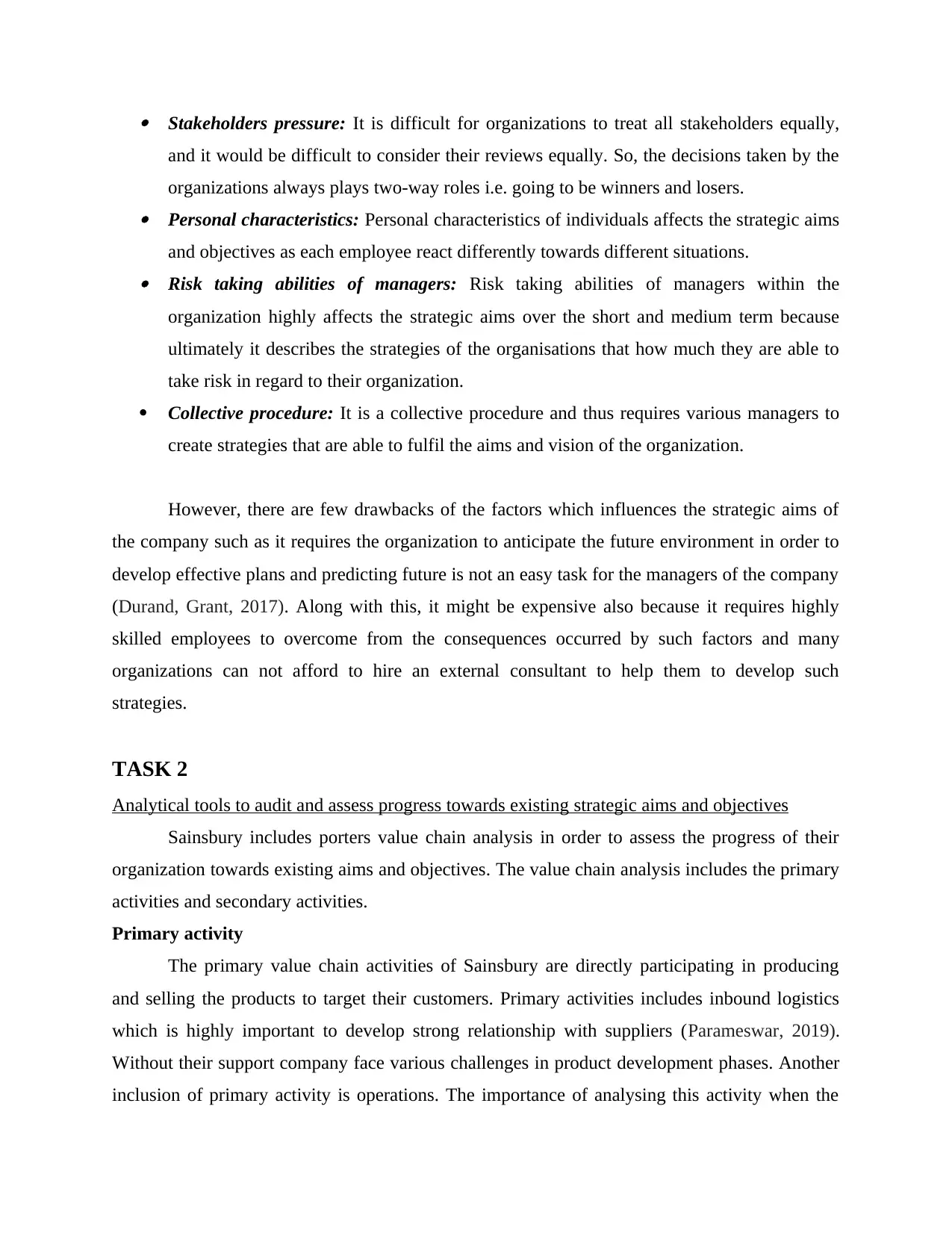
Stakeholders pressure: It is difficult for organizations to treat all stakeholders equally,
and it would be difficult to consider their reviews equally. So, the decisions taken by the
organizations always plays two-way roles i.e. going to be winners and losers. Personal characteristics: Personal characteristics of individuals affects the strategic aims
and objectives as each employee react differently towards different situations. Risk taking abilities of managers: Risk taking abilities of managers within the
organization highly affects the strategic aims over the short and medium term because
ultimately it describes the strategies of the organisations that how much they are able to
take risk in regard to their organization.
Collective procedure: It is a collective procedure and thus requires various managers to
create strategies that are able to fulfil the aims and vision of the organization.
However, there are few drawbacks of the factors which influences the strategic aims of
the company such as it requires the organization to anticipate the future environment in order to
develop effective plans and predicting future is not an easy task for the managers of the company
(Durand, Grant, 2017). Along with this, it might be expensive also because it requires highly
skilled employees to overcome from the consequences occurred by such factors and many
organizations can not afford to hire an external consultant to help them to develop such
strategies.
TASK 2
Analytical tools to audit and assess progress towards existing strategic aims and objectives
Sainsbury includes porters value chain analysis in order to assess the progress of their
organization towards existing aims and objectives. The value chain analysis includes the primary
activities and secondary activities.
Primary activity
The primary value chain activities of Sainsbury are directly participating in producing
and selling the products to target their customers. Primary activities includes inbound logistics
which is highly important to develop strong relationship with suppliers (Parameswar, 2019).
Without their support company face various challenges in product development phases. Another
inclusion of primary activity is operations. The importance of analysing this activity when the
and it would be difficult to consider their reviews equally. So, the decisions taken by the
organizations always plays two-way roles i.e. going to be winners and losers. Personal characteristics: Personal characteristics of individuals affects the strategic aims
and objectives as each employee react differently towards different situations. Risk taking abilities of managers: Risk taking abilities of managers within the
organization highly affects the strategic aims over the short and medium term because
ultimately it describes the strategies of the organisations that how much they are able to
take risk in regard to their organization.
Collective procedure: It is a collective procedure and thus requires various managers to
create strategies that are able to fulfil the aims and vision of the organization.
However, there are few drawbacks of the factors which influences the strategic aims of
the company such as it requires the organization to anticipate the future environment in order to
develop effective plans and predicting future is not an easy task for the managers of the company
(Durand, Grant, 2017). Along with this, it might be expensive also because it requires highly
skilled employees to overcome from the consequences occurred by such factors and many
organizations can not afford to hire an external consultant to help them to develop such
strategies.
TASK 2
Analytical tools to audit and assess progress towards existing strategic aims and objectives
Sainsbury includes porters value chain analysis in order to assess the progress of their
organization towards existing aims and objectives. The value chain analysis includes the primary
activities and secondary activities.
Primary activity
The primary value chain activities of Sainsbury are directly participating in producing
and selling the products to target their customers. Primary activities includes inbound logistics
which is highly important to develop strong relationship with suppliers (Parameswar, 2019).
Without their support company face various challenges in product development phases. Another
inclusion of primary activity is operations. The importance of analysing this activity when the
⊘ This is a preview!⊘
Do you want full access?
Subscribe today to unlock all pages.

Trusted by 1+ million students worldwide
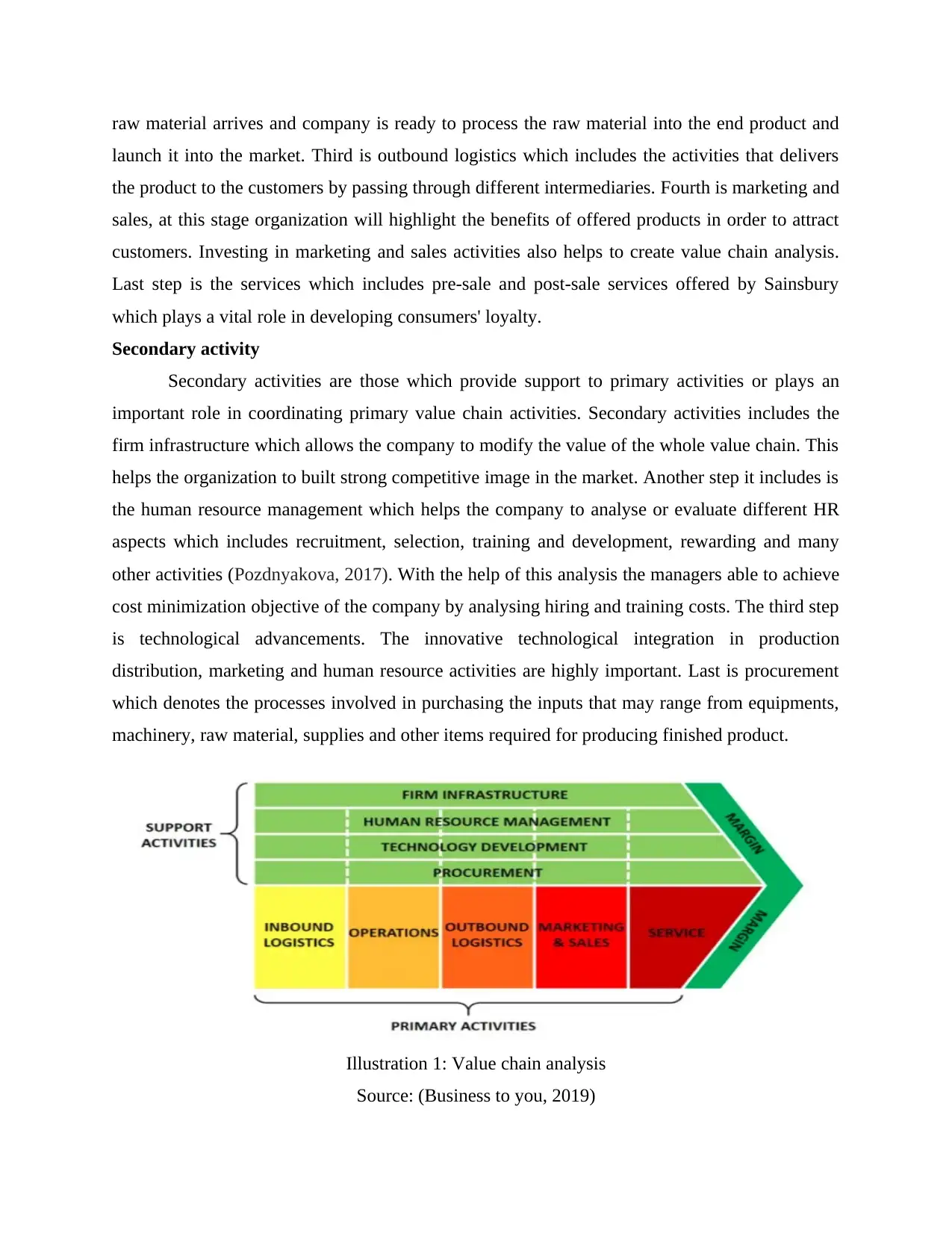
raw material arrives and company is ready to process the raw material into the end product and
launch it into the market. Third is outbound logistics which includes the activities that delivers
the product to the customers by passing through different intermediaries. Fourth is marketing and
sales, at this stage organization will highlight the benefits of offered products in order to attract
customers. Investing in marketing and sales activities also helps to create value chain analysis.
Last step is the services which includes pre-sale and post-sale services offered by Sainsbury
which plays a vital role in developing consumers' loyalty.
Secondary activity
Secondary activities are those which provide support to primary activities or plays an
important role in coordinating primary value chain activities. Secondary activities includes the
firm infrastructure which allows the company to modify the value of the whole value chain. This
helps the organization to built strong competitive image in the market. Another step it includes is
the human resource management which helps the company to analyse or evaluate different HR
aspects which includes recruitment, selection, training and development, rewarding and many
other activities (Pozdnyakova, 2017). With the help of this analysis the managers able to achieve
cost minimization objective of the company by analysing hiring and training costs. The third step
is technological advancements. The innovative technological integration in production
distribution, marketing and human resource activities are highly important. Last is procurement
which denotes the processes involved in purchasing the inputs that may range from equipments,
machinery, raw material, supplies and other items required for producing finished product.
Illustration 1: Value chain analysis
Source: (Business to you, 2019)
launch it into the market. Third is outbound logistics which includes the activities that delivers
the product to the customers by passing through different intermediaries. Fourth is marketing and
sales, at this stage organization will highlight the benefits of offered products in order to attract
customers. Investing in marketing and sales activities also helps to create value chain analysis.
Last step is the services which includes pre-sale and post-sale services offered by Sainsbury
which plays a vital role in developing consumers' loyalty.
Secondary activity
Secondary activities are those which provide support to primary activities or plays an
important role in coordinating primary value chain activities. Secondary activities includes the
firm infrastructure which allows the company to modify the value of the whole value chain. This
helps the organization to built strong competitive image in the market. Another step it includes is
the human resource management which helps the company to analyse or evaluate different HR
aspects which includes recruitment, selection, training and development, rewarding and many
other activities (Pozdnyakova, 2017). With the help of this analysis the managers able to achieve
cost minimization objective of the company by analysing hiring and training costs. The third step
is technological advancements. The innovative technological integration in production
distribution, marketing and human resource activities are highly important. Last is procurement
which denotes the processes involved in purchasing the inputs that may range from equipments,
machinery, raw material, supplies and other items required for producing finished product.
Illustration 1: Value chain analysis
Source: (Business to you, 2019)
Paraphrase This Document
Need a fresh take? Get an instant paraphrase of this document with our AI Paraphraser
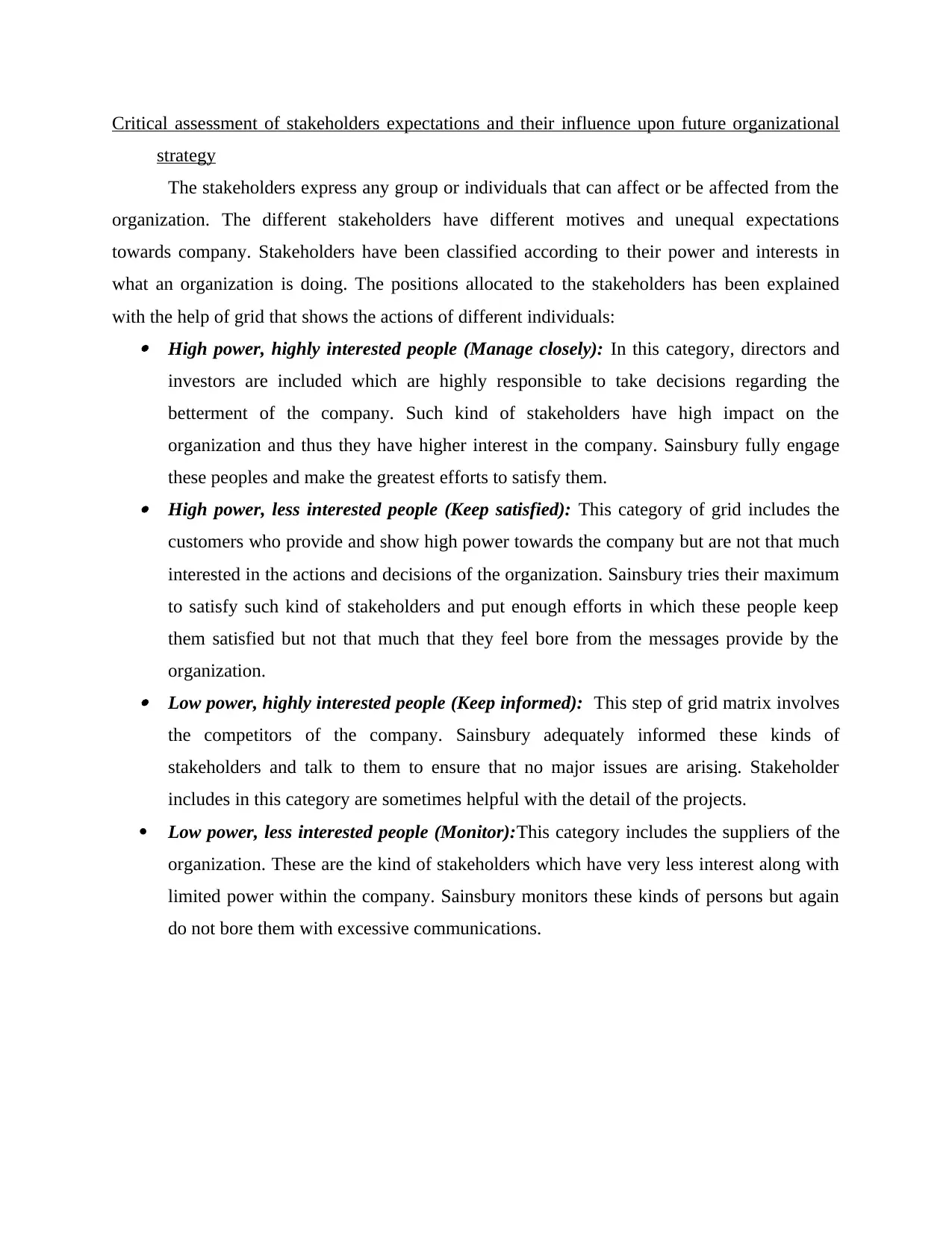
Critical assessment of stakeholders expectations and their influence upon future organizational
strategy
The stakeholders express any group or individuals that can affect or be affected from the
organization. The different stakeholders have different motives and unequal expectations
towards company. Stakeholders have been classified according to their power and interests in
what an organization is doing. The positions allocated to the stakeholders has been explained
with the help of grid that shows the actions of different individuals: High power, highly interested people (Manage closely): In this category, directors and
investors are included which are highly responsible to take decisions regarding the
betterment of the company. Such kind of stakeholders have high impact on the
organization and thus they have higher interest in the company. Sainsbury fully engage
these peoples and make the greatest efforts to satisfy them. High power, less interested people (Keep satisfied): This category of grid includes the
customers who provide and show high power towards the company but are not that much
interested in the actions and decisions of the organization. Sainsbury tries their maximum
to satisfy such kind of stakeholders and put enough efforts in which these people keep
them satisfied but not that much that they feel bore from the messages provide by the
organization. Low power, highly interested people (Keep informed): This step of grid matrix involves
the competitors of the company. Sainsbury adequately informed these kinds of
stakeholders and talk to them to ensure that no major issues are arising. Stakeholder
includes in this category are sometimes helpful with the detail of the projects.
Low power, less interested people (Monitor):This category includes the suppliers of the
organization. These are the kind of stakeholders which have very less interest along with
limited power within the company. Sainsbury monitors these kinds of persons but again
do not bore them with excessive communications.
strategy
The stakeholders express any group or individuals that can affect or be affected from the
organization. The different stakeholders have different motives and unequal expectations
towards company. Stakeholders have been classified according to their power and interests in
what an organization is doing. The positions allocated to the stakeholders has been explained
with the help of grid that shows the actions of different individuals: High power, highly interested people (Manage closely): In this category, directors and
investors are included which are highly responsible to take decisions regarding the
betterment of the company. Such kind of stakeholders have high impact on the
organization and thus they have higher interest in the company. Sainsbury fully engage
these peoples and make the greatest efforts to satisfy them. High power, less interested people (Keep satisfied): This category of grid includes the
customers who provide and show high power towards the company but are not that much
interested in the actions and decisions of the organization. Sainsbury tries their maximum
to satisfy such kind of stakeholders and put enough efforts in which these people keep
them satisfied but not that much that they feel bore from the messages provide by the
organization. Low power, highly interested people (Keep informed): This step of grid matrix involves
the competitors of the company. Sainsbury adequately informed these kinds of
stakeholders and talk to them to ensure that no major issues are arising. Stakeholder
includes in this category are sometimes helpful with the detail of the projects.
Low power, less interested people (Monitor):This category includes the suppliers of the
organization. These are the kind of stakeholders which have very less interest along with
limited power within the company. Sainsbury monitors these kinds of persons but again
do not bore them with excessive communications.
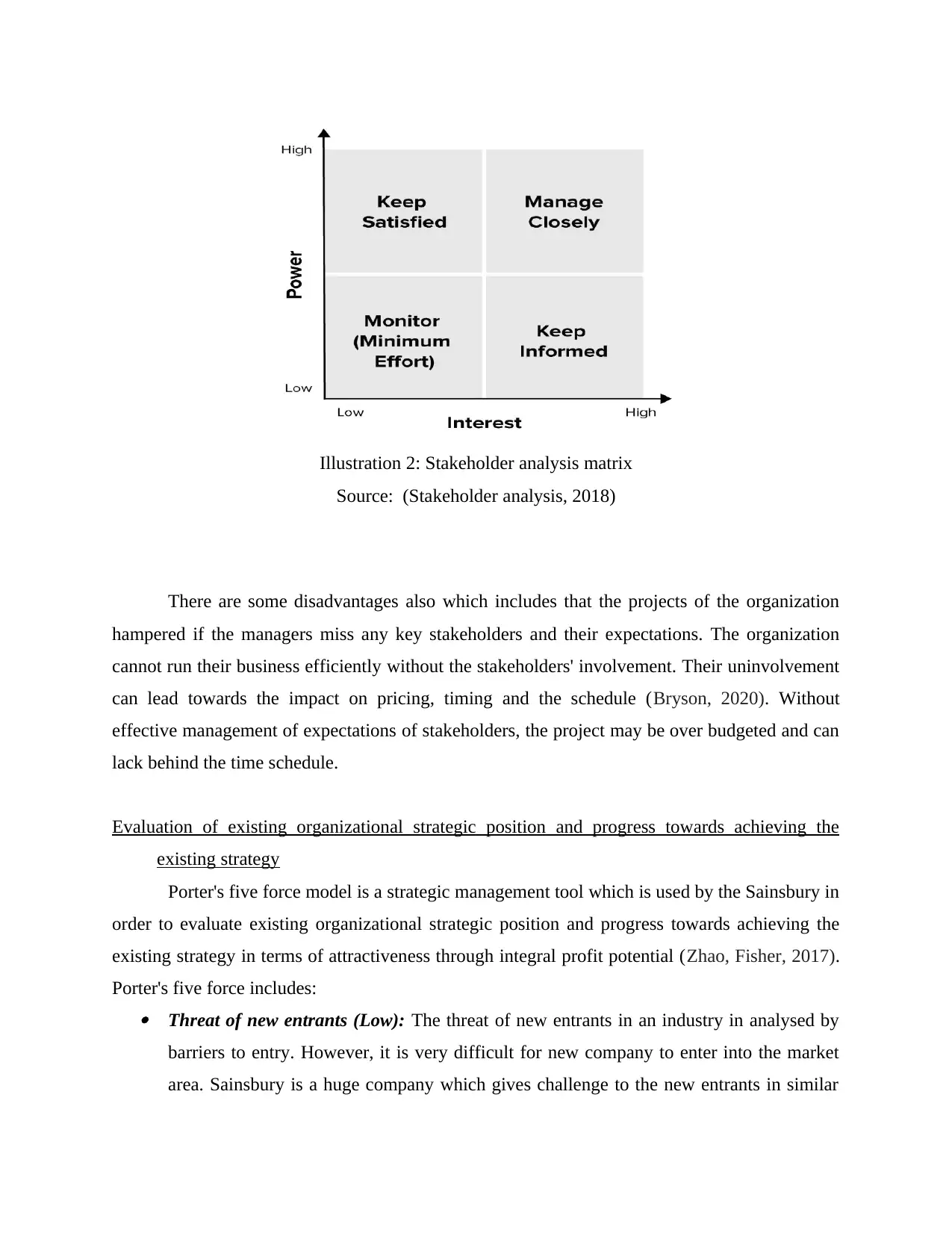
There are some disadvantages also which includes that the projects of the organization
hampered if the managers miss any key stakeholders and their expectations. The organization
cannot run their business efficiently without the stakeholders' involvement. Their uninvolvement
can lead towards the impact on pricing, timing and the schedule (Bryson, 2020). Without
effective management of expectations of stakeholders, the project may be over budgeted and can
lack behind the time schedule.
Evaluation of existing organizational strategic position and progress towards achieving the
existing strategy
Porter's five force model is a strategic management tool which is used by the Sainsbury in
order to evaluate existing organizational strategic position and progress towards achieving the
existing strategy in terms of attractiveness through integral profit potential (Zhao, Fisher, 2017).
Porter's five force includes: Threat of new entrants (Low): The threat of new entrants in an industry in analysed by
barriers to entry. However, it is very difficult for new company to enter into the market
area. Sainsbury is a huge company which gives challenge to the new entrants in similar
Illustration 2: Stakeholder analysis matrix
Source: (Stakeholder analysis, 2018)
hampered if the managers miss any key stakeholders and their expectations. The organization
cannot run their business efficiently without the stakeholders' involvement. Their uninvolvement
can lead towards the impact on pricing, timing and the schedule (Bryson, 2020). Without
effective management of expectations of stakeholders, the project may be over budgeted and can
lack behind the time schedule.
Evaluation of existing organizational strategic position and progress towards achieving the
existing strategy
Porter's five force model is a strategic management tool which is used by the Sainsbury in
order to evaluate existing organizational strategic position and progress towards achieving the
existing strategy in terms of attractiveness through integral profit potential (Zhao, Fisher, 2017).
Porter's five force includes: Threat of new entrants (Low): The threat of new entrants in an industry in analysed by
barriers to entry. However, it is very difficult for new company to enter into the market
area. Sainsbury is a huge company which gives challenge to the new entrants in similar
Illustration 2: Stakeholder analysis matrix
Source: (Stakeholder analysis, 2018)
⊘ This is a preview!⊘
Do you want full access?
Subscribe today to unlock all pages.

Trusted by 1+ million students worldwide
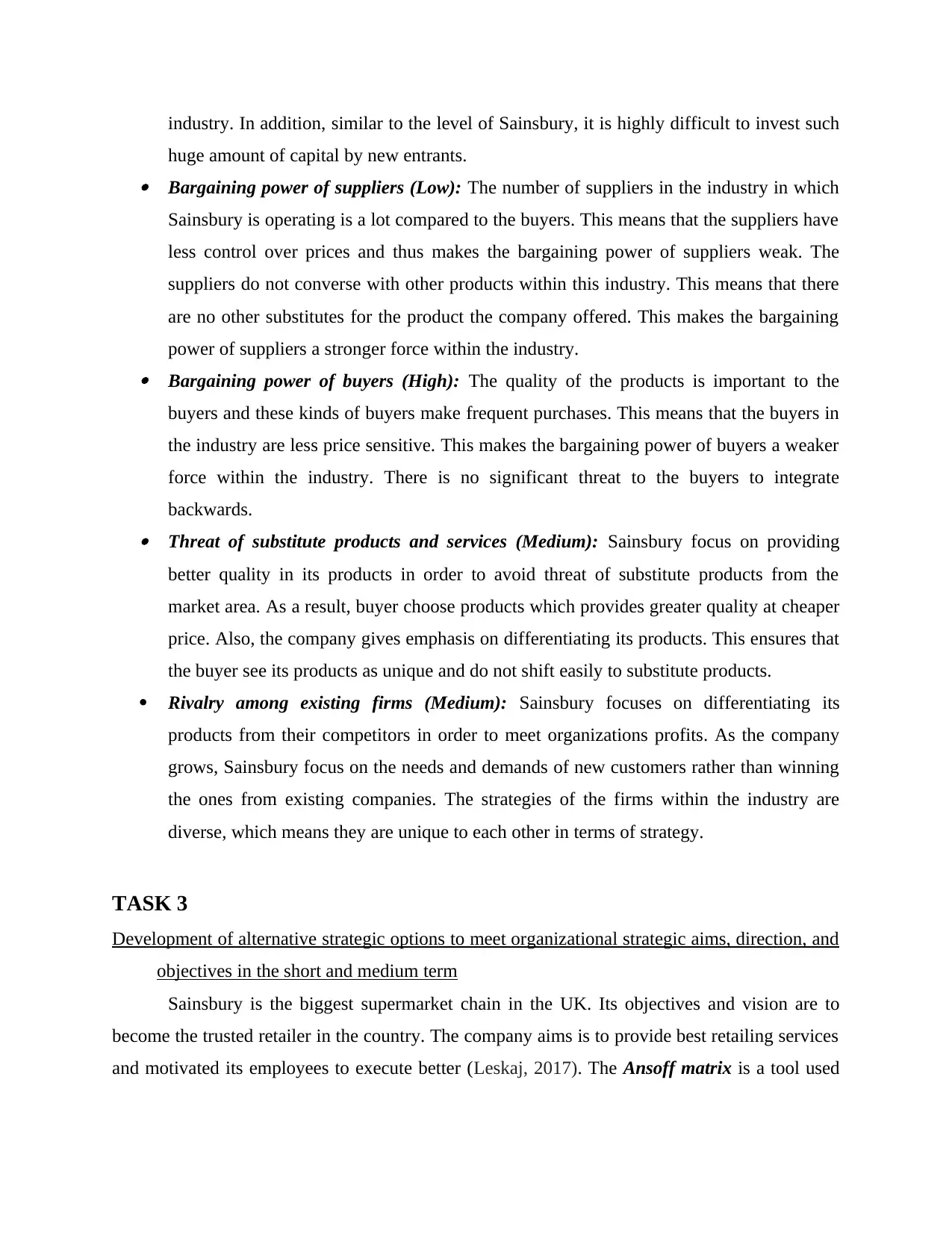
industry. In addition, similar to the level of Sainsbury, it is highly difficult to invest such
huge amount of capital by new entrants. Bargaining power of suppliers (Low): The number of suppliers in the industry in which
Sainsbury is operating is a lot compared to the buyers. This means that the suppliers have
less control over prices and thus makes the bargaining power of suppliers weak. The
suppliers do not converse with other products within this industry. This means that there
are no other substitutes for the product the company offered. This makes the bargaining
power of suppliers a stronger force within the industry. Bargaining power of buyers (High): The quality of the products is important to the
buyers and these kinds of buyers make frequent purchases. This means that the buyers in
the industry are less price sensitive. This makes the bargaining power of buyers a weaker
force within the industry. There is no significant threat to the buyers to integrate
backwards. Threat of substitute products and services (Medium): Sainsbury focus on providing
better quality in its products in order to avoid threat of substitute products from the
market area. As a result, buyer choose products which provides greater quality at cheaper
price. Also, the company gives emphasis on differentiating its products. This ensures that
the buyer see its products as unique and do not shift easily to substitute products.
Rivalry among existing firms (Medium): Sainsbury focuses on differentiating its
products from their competitors in order to meet organizations profits. As the company
grows, Sainsbury focus on the needs and demands of new customers rather than winning
the ones from existing companies. The strategies of the firms within the industry are
diverse, which means they are unique to each other in terms of strategy.
TASK 3
Development of alternative strategic options to meet organizational strategic aims, direction, and
objectives in the short and medium term
Sainsbury is the biggest supermarket chain in the UK. Its objectives and vision are to
become the trusted retailer in the country. The company aims is to provide best retailing services
and motivated its employees to execute better (Leskaj, 2017). The Ansoff matrix is a tool used
huge amount of capital by new entrants. Bargaining power of suppliers (Low): The number of suppliers in the industry in which
Sainsbury is operating is a lot compared to the buyers. This means that the suppliers have
less control over prices and thus makes the bargaining power of suppliers weak. The
suppliers do not converse with other products within this industry. This means that there
are no other substitutes for the product the company offered. This makes the bargaining
power of suppliers a stronger force within the industry. Bargaining power of buyers (High): The quality of the products is important to the
buyers and these kinds of buyers make frequent purchases. This means that the buyers in
the industry are less price sensitive. This makes the bargaining power of buyers a weaker
force within the industry. There is no significant threat to the buyers to integrate
backwards. Threat of substitute products and services (Medium): Sainsbury focus on providing
better quality in its products in order to avoid threat of substitute products from the
market area. As a result, buyer choose products which provides greater quality at cheaper
price. Also, the company gives emphasis on differentiating its products. This ensures that
the buyer see its products as unique and do not shift easily to substitute products.
Rivalry among existing firms (Medium): Sainsbury focuses on differentiating its
products from their competitors in order to meet organizations profits. As the company
grows, Sainsbury focus on the needs and demands of new customers rather than winning
the ones from existing companies. The strategies of the firms within the industry are
diverse, which means they are unique to each other in terms of strategy.
TASK 3
Development of alternative strategic options to meet organizational strategic aims, direction, and
objectives in the short and medium term
Sainsbury is the biggest supermarket chain in the UK. Its objectives and vision are to
become the trusted retailer in the country. The company aims is to provide best retailing services
and motivated its employees to execute better (Leskaj, 2017). The Ansoff matrix is a tool used
Paraphrase This Document
Need a fresh take? Get an instant paraphrase of this document with our AI Paraphraser
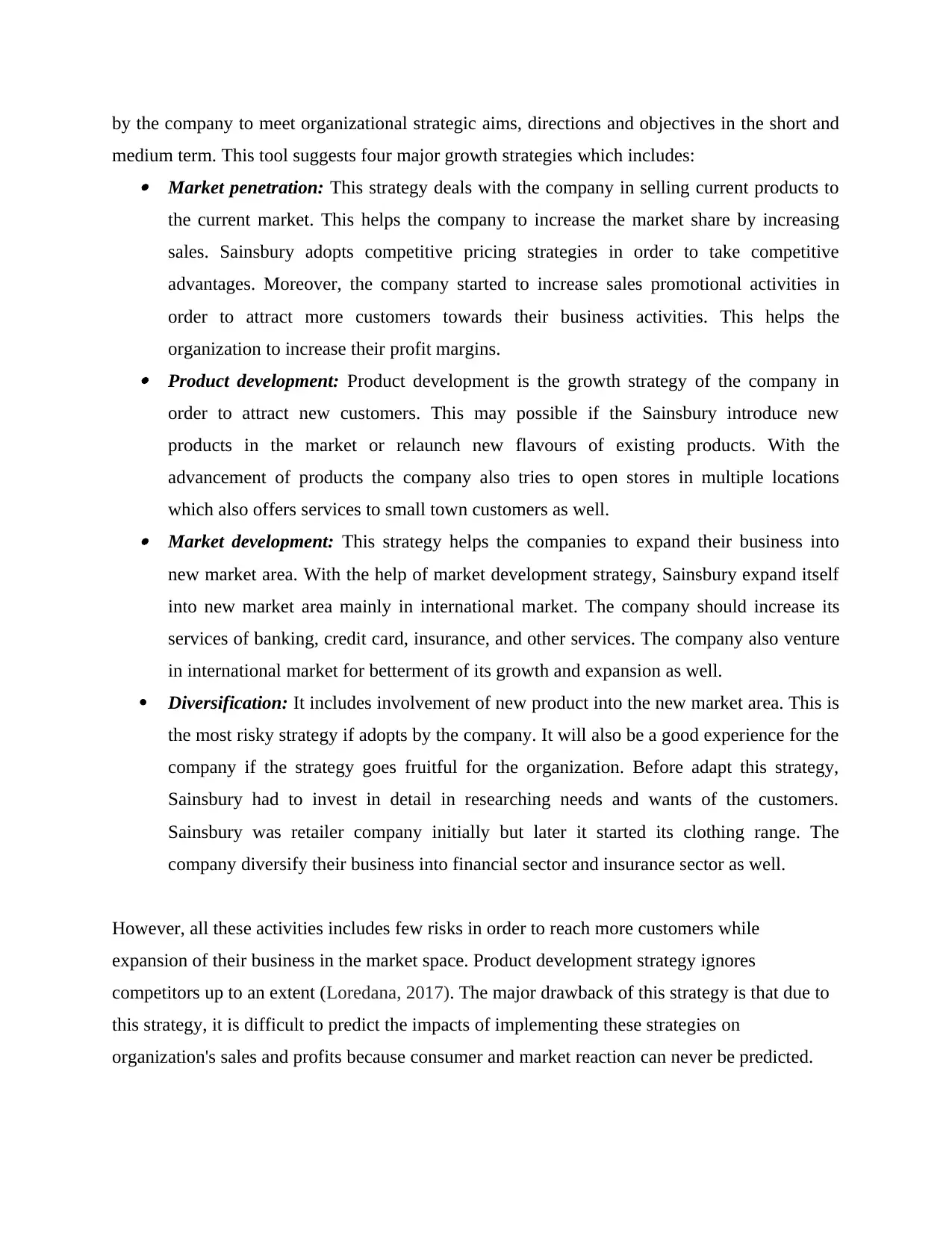
by the company to meet organizational strategic aims, directions and objectives in the short and
medium term. This tool suggests four major growth strategies which includes: Market penetration: This strategy deals with the company in selling current products to
the current market. This helps the company to increase the market share by increasing
sales. Sainsbury adopts competitive pricing strategies in order to take competitive
advantages. Moreover, the company started to increase sales promotional activities in
order to attract more customers towards their business activities. This helps the
organization to increase their profit margins. Product development: Product development is the growth strategy of the company in
order to attract new customers. This may possible if the Sainsbury introduce new
products in the market or relaunch new flavours of existing products. With the
advancement of products the company also tries to open stores in multiple locations
which also offers services to small town customers as well. Market development: This strategy helps the companies to expand their business into
new market area. With the help of market development strategy, Sainsbury expand itself
into new market area mainly in international market. The company should increase its
services of banking, credit card, insurance, and other services. The company also venture
in international market for betterment of its growth and expansion as well.
Diversification: It includes involvement of new product into the new market area. This is
the most risky strategy if adopts by the company. It will also be a good experience for the
company if the strategy goes fruitful for the organization. Before adapt this strategy,
Sainsbury had to invest in detail in researching needs and wants of the customers.
Sainsbury was retailer company initially but later it started its clothing range. The
company diversify their business into financial sector and insurance sector as well.
However, all these activities includes few risks in order to reach more customers while
expansion of their business in the market space. Product development strategy ignores
competitors up to an extent (Loredana, 2017). The major drawback of this strategy is that due to
this strategy, it is difficult to predict the impacts of implementing these strategies on
organization's sales and profits because consumer and market reaction can never be predicted.
medium term. This tool suggests four major growth strategies which includes: Market penetration: This strategy deals with the company in selling current products to
the current market. This helps the company to increase the market share by increasing
sales. Sainsbury adopts competitive pricing strategies in order to take competitive
advantages. Moreover, the company started to increase sales promotional activities in
order to attract more customers towards their business activities. This helps the
organization to increase their profit margins. Product development: Product development is the growth strategy of the company in
order to attract new customers. This may possible if the Sainsbury introduce new
products in the market or relaunch new flavours of existing products. With the
advancement of products the company also tries to open stores in multiple locations
which also offers services to small town customers as well. Market development: This strategy helps the companies to expand their business into
new market area. With the help of market development strategy, Sainsbury expand itself
into new market area mainly in international market. The company should increase its
services of banking, credit card, insurance, and other services. The company also venture
in international market for betterment of its growth and expansion as well.
Diversification: It includes involvement of new product into the new market area. This is
the most risky strategy if adopts by the company. It will also be a good experience for the
company if the strategy goes fruitful for the organization. Before adapt this strategy,
Sainsbury had to invest in detail in researching needs and wants of the customers.
Sainsbury was retailer company initially but later it started its clothing range. The
company diversify their business into financial sector and insurance sector as well.
However, all these activities includes few risks in order to reach more customers while
expansion of their business in the market space. Product development strategy ignores
competitors up to an extent (Loredana, 2017). The major drawback of this strategy is that due to
this strategy, it is difficult to predict the impacts of implementing these strategies on
organization's sales and profits because consumer and market reaction can never be predicted.
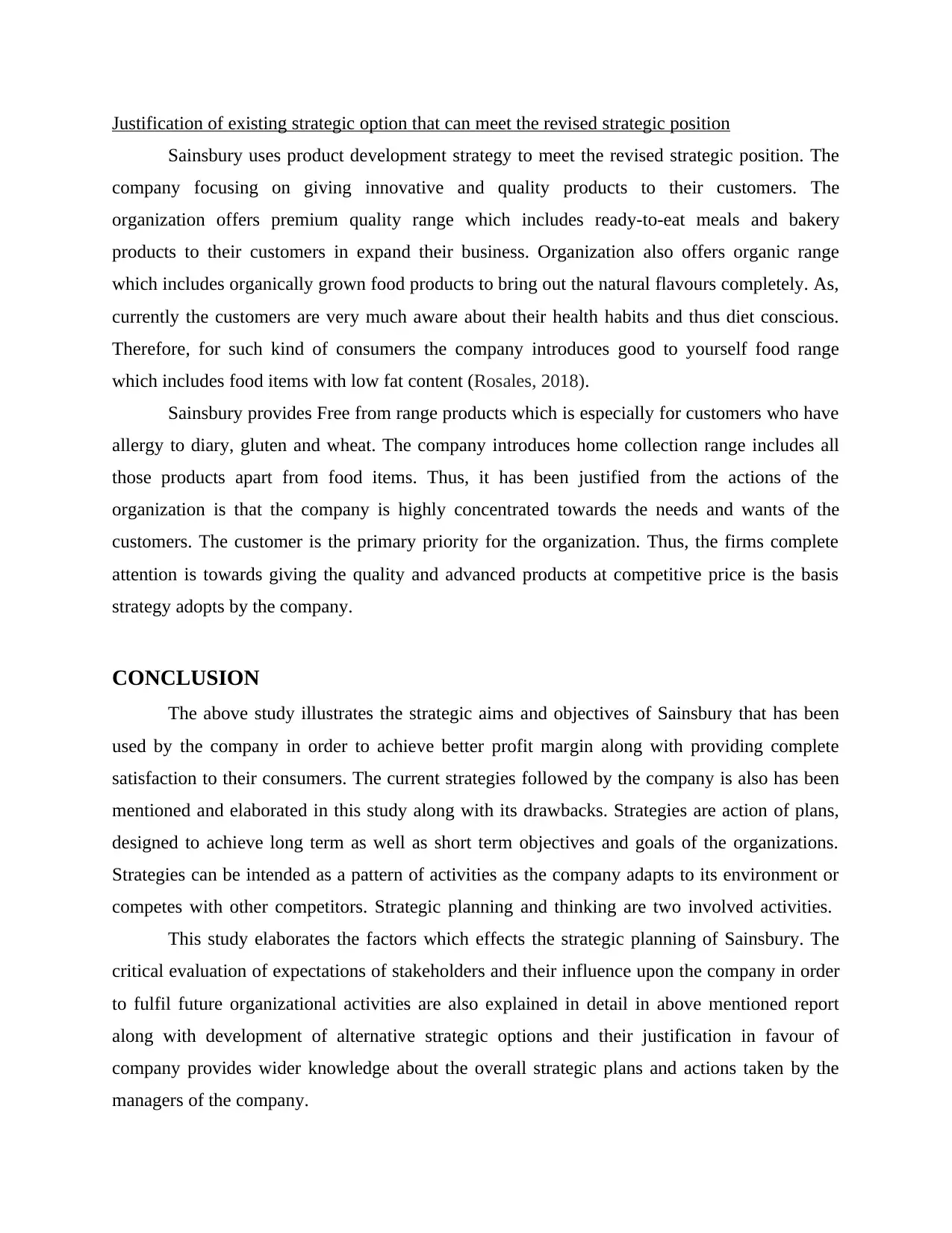
Justification of existing strategic option that can meet the revised strategic position
Sainsbury uses product development strategy to meet the revised strategic position. The
company focusing on giving innovative and quality products to their customers. The
organization offers premium quality range which includes ready-to-eat meals and bakery
products to their customers in expand their business. Organization also offers organic range
which includes organically grown food products to bring out the natural flavours completely. As,
currently the customers are very much aware about their health habits and thus diet conscious.
Therefore, for such kind of consumers the company introduces good to yourself food range
which includes food items with low fat content (Rosales, 2018).
Sainsbury provides Free from range products which is especially for customers who have
allergy to diary, gluten and wheat. The company introduces home collection range includes all
those products apart from food items. Thus, it has been justified from the actions of the
organization is that the company is highly concentrated towards the needs and wants of the
customers. The customer is the primary priority for the organization. Thus, the firms complete
attention is towards giving the quality and advanced products at competitive price is the basis
strategy adopts by the company.
CONCLUSION
The above study illustrates the strategic aims and objectives of Sainsbury that has been
used by the company in order to achieve better profit margin along with providing complete
satisfaction to their consumers. The current strategies followed by the company is also has been
mentioned and elaborated in this study along with its drawbacks. Strategies are action of plans,
designed to achieve long term as well as short term objectives and goals of the organizations.
Strategies can be intended as a pattern of activities as the company adapts to its environment or
competes with other competitors. Strategic planning and thinking are two involved activities.
This study elaborates the factors which effects the strategic planning of Sainsbury. The
critical evaluation of expectations of stakeholders and their influence upon the company in order
to fulfil future organizational activities are also explained in detail in above mentioned report
along with development of alternative strategic options and their justification in favour of
company provides wider knowledge about the overall strategic plans and actions taken by the
managers of the company.
Sainsbury uses product development strategy to meet the revised strategic position. The
company focusing on giving innovative and quality products to their customers. The
organization offers premium quality range which includes ready-to-eat meals and bakery
products to their customers in expand their business. Organization also offers organic range
which includes organically grown food products to bring out the natural flavours completely. As,
currently the customers are very much aware about their health habits and thus diet conscious.
Therefore, for such kind of consumers the company introduces good to yourself food range
which includes food items with low fat content (Rosales, 2018).
Sainsbury provides Free from range products which is especially for customers who have
allergy to diary, gluten and wheat. The company introduces home collection range includes all
those products apart from food items. Thus, it has been justified from the actions of the
organization is that the company is highly concentrated towards the needs and wants of the
customers. The customer is the primary priority for the organization. Thus, the firms complete
attention is towards giving the quality and advanced products at competitive price is the basis
strategy adopts by the company.
CONCLUSION
The above study illustrates the strategic aims and objectives of Sainsbury that has been
used by the company in order to achieve better profit margin along with providing complete
satisfaction to their consumers. The current strategies followed by the company is also has been
mentioned and elaborated in this study along with its drawbacks. Strategies are action of plans,
designed to achieve long term as well as short term objectives and goals of the organizations.
Strategies can be intended as a pattern of activities as the company adapts to its environment or
competes with other competitors. Strategic planning and thinking are two involved activities.
This study elaborates the factors which effects the strategic planning of Sainsbury. The
critical evaluation of expectations of stakeholders and their influence upon the company in order
to fulfil future organizational activities are also explained in detail in above mentioned report
along with development of alternative strategic options and their justification in favour of
company provides wider knowledge about the overall strategic plans and actions taken by the
managers of the company.
⊘ This is a preview!⊘
Do you want full access?
Subscribe today to unlock all pages.

Trusted by 1+ million students worldwide
1 out of 13
Related Documents
Your All-in-One AI-Powered Toolkit for Academic Success.
+13062052269
info@desklib.com
Available 24*7 on WhatsApp / Email
![[object Object]](/_next/static/media/star-bottom.7253800d.svg)
Unlock your academic potential
Copyright © 2020–2025 A2Z Services. All Rights Reserved. Developed and managed by ZUCOL.





